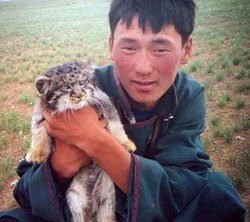Google does not understand the name of this wild cat species, “Manul”. In the recent past if you searched for it, Google found pages about “manuals”. Manuals on cars or any bit of machinery that Google can find – mighty Google was confused – how strange was that? They have corrected that little error recently. But custom search still tries to produce manuals!
Mr Pallas
The person who discovered this small and strange looking wild cat species was a Mr Simon Peter Pallas. He was German. He discovered this cat in 1776. An alternative name for the Manul is “Pallas’s cat”. The name “Manul” comes from the Mongolian name. Although I don’t what it is.
This fantastic little wild cat lives in mid-Asia including Mongolia. It can be found in that rather unknown blank area on the world map above India and China. It is a large area. Rather inhospitable.
Three of the pictures are by the same photographer and are similar. I chose them because they are very good. You can see this cat clearly. Also they are licensed for use (as are all the others) on other websites under a creative commons license – thank you.
These are “thumbnail” images. You click on them to see the full-sized image.
Link to Tambako The Jaguar on Flickr
Grumpy
I have added another picture from an earlier post that has probably become invisible over time. I think it is a fine photograph. Pallas’s cat looks like a grumpy cat. This is really just about appearance, which, I believe, misrepresents the cat’s emotions. I don’t think this wild cat is anymore grumpy than any of the other wild cats. Although in the picture below, if you look at his face carefully he seems to be mildly amused and quite contented with his predicament. There is also a vague similarity between the appearance of this cat and the appearance of an old man. He may have been slightly sedated.

Persian Cat
Many years ago some people in the cat fancy (the people who breed and show purebred cats) believed that the Pallas’s cat was the wild cat ancestor of the Persian cat. There is a certain loose similarity. The idea has been consigned to the archive and is no longer viable. The Persian cat comes from the African wildcat via a lot of selective breeding by cat breeders.
Pallas’s Cat in Summary
It lives in what we consider rather desolate places of high altitude grassland and “rocky alpine deserts”. The landscape is severe, cold and dry. The Manul has long fur to deal with this harsh environment. This cat weighs from about 4 to 10 pounds putting on a par with a small to average domestic cat. The picture in the gallery of the Mongolian man holding a Pallas’s cat gives a nice indication of size. They are excellent rock climbers as expected and they are sociable. The appear to exchange scent by rubbing their bodies against each other when greeting. Prey is small mammals and birds.








Where can i buy a pallas cat?
Hi Boris. I would not recommend buying a Pallas cat. This is because they are a small wild cat species. There will be regulations in various states of the USA which will restrict the keeping of exotic animals and this cat will fall under that heading. Also, the tame wild cat is never going to be the same as a true domestic cat. A lot of people who keep 1st filial wildcat hybrids struggle with caring for them because their temperaments are not what they expected and these cats are considerably more demanding than a domestic cat. Wild cats as pets are often failures for the owner and for example they also spray urine a lot more or there is the possibility of that. Then they might escape and get shot by somebody. I don’t think you could call it a relaxed relationship so personally, unless you are an experienced exotic animal caretaker I would reconsider.
Because they are wildcats you will find it difficult to buy one. And if you do buy one it may well have been imported from its native country and therefore in buying one you encourage the abuse of this wild cat in the wild and endanger the species. Sorry to be so negative and thank you for visiting and asking.
What a striking face and those yellow eyes are beautiful.
When film from a camera trap set to film Snow Leopards in the Himalaya’s was reviewed recently, they were shocked to see several pallas cat’s! They are either climbing higher due to global warming, or they have a larger habitat than originally thought. Our neighbor’s last name is Pallas. They never heard of the cat. 🙂
Your neighbour might have a German heritage. Yes, I read that about Pallas’s cat occupying places were the snow leopard is found. Bengal tigers have moved up into the Himalayas. When wild cats go to more remote places they are probably getting away from humans 🙂 Humans do persecute Pallas’s cat and the tiger too.
Beautiful cat! But if it’s wild, how did you carry it in a backpack? 🙂
Agreed. Two ways: (1) Pallas’s cat is quite mild mannered. Some small wild cats are. The margay and jaguarundi come to mind and the Andean cat – all three are pretty gentle and can be domesticated and (2) it was mildly sedated for the trip.